Subjects I will look at include golden eagles as used by the Mongolian eagle hunters, falconry in the Middle East, Europe, and North America, owls and hawks as natural 'rodent control' on farms, and the place of birds of prey as deities, such as the harpy eagle in South America, the bald and golden eagles by Native Americans, and the vulture and falcon in ancient Egypt.
I have completed the first painting of 15, which depicts the golden eagle of the Mongolian eagle hunters. As I will be showing these for my thesis exhibition, I have chosen not to publish them online until after my exhibition. However, I will continuously be uploading the sketches and works in progress here as I complete them.
The second painting I am working on depicts the barn owl. A nice quote I found concerning the hunting skill of this intriguing bird is summed up quite well by Ted Andrews in his book, Animal Speak: "A barn owl can kill ten times the amount of mice than a cat in a single night and more if there are young to be fed.” This fact has been reiterated in a number of texts, including Iain Taylor's "Barn Owls: Predator-Prey Relationships and Conservation and Angus Cameron and Peter Parnall's The Nightwatchers. The fact that barn owls are simply excellent at hunting mice seems pervasive. Unfortunately, this knowledge wasn't always so widespread. Owls, as well as many buteos have historically been shot, trapped, and poisoned by farmers who incorrectly believe them to be poultry hunters. The ironic truth is that without these birds to control rodent populations, many a farmer finds his crops overrun by mice, voles, and other small mammals.
Here is one page of rough sketches:
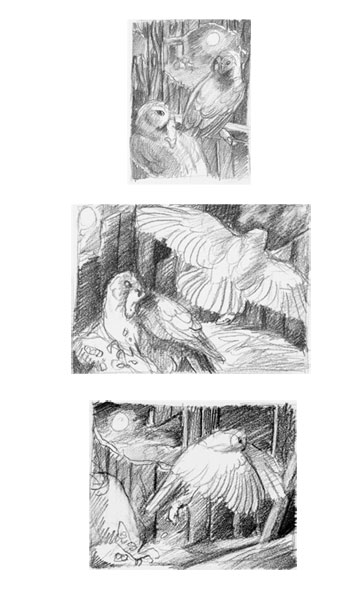
For my final painting, I combined aspects of the bottom two. I liked the almost-profile view of the owl in flight, but I also wanted an owl perched, in the bottom left corner. I also found several problems with light sources (such as the moon behind the owl, which is illuminated from the other side), which I fixed in the final sketch.
This is the final drawing on the stretched watercolor paper (about 10.5 X 17 inches). I have purposefully left the owls undetailed, as I will be masking them with masking fluid to keep their edges crisp and white for when I do the first, broad washes for the background.
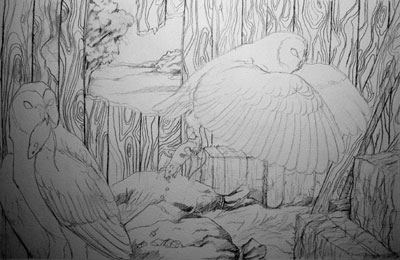
I have developed a fondness for barn owls after doing all this research on them. Their lifespans are strangely short for a bird of prey (under 8 years for most - owls in general usually live at least 10 to 15 years, and many hawks and eagles live up to 30 years in the wild). Paired with their almost ethereal appearance and presence, they seem almost otherworldly. Spiritual. Every time I look at the gray, white, and brown plumage of a barn owl, I cannot help but think of how these birds have such a natural aesthetic! I look forward to painting this one.

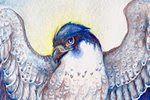
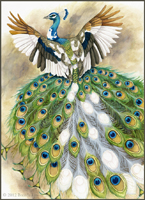
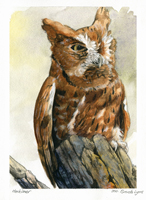
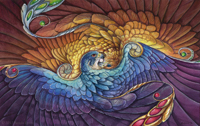
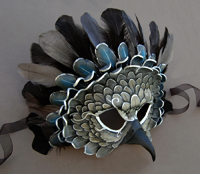
I never knew that owls were hunted and killed for such a reason. I am glad that they were not driven to extinction. Out of all birds, I've always found owls the most intriguing visually and physically. Their natural ability to hunt and their unique facial structure makes them stand out against the crowd (even long before Jareth popularized the Snow Owl, my personal favorite breed of owl).
ReplyDeleteI'm really liking the detail you've put into the background textures and the contrast of the owl forms. I'm looking forward to seeing how you play with the soft moonlight filtering down in this scene to add to the night time atmosphere. I imagine the glint of their eyes will play a significance as well?
And a random technical question for you, do you spray your pencil with workable fixative before you put the masking fluid on it? I didn't on the Ramah piece and it stripped up my pencil details horribly.
Or is that image inked? *squints*
I don't spray the image with fixative, though that's a good way to keep the pencil from coming up with the masking fluid. I choose, however, to simply leave the masked areas undetailed until after. Actually I mentioned above, "I have purposefully left the owls undetailed, as I will be masking them with masking fluid to keep their edges crisp and white for when I do the first, broad washes for the background." I don't put the details in the owls until after I remove the masking fluid for exactly this reason.
ReplyDeleteAnd I decided, as I was putting the washes in, that I was going to have it an early dawn scene instead of moonlight, as I wanted the colors to be warm. Barn owls hunt at dawn, as well as at sunset and midnight.
Well even the basic pencil outlines were stripped up, which is what I'm talking about (not just my detail lines). I also masked in the full area instead of just the borders, which I notice you've done here. At the most, it will only strip your outside edges, which isn't so bad as stripping it ALL off. I didn't think to just mask the borders of color till after I'd made that mistake, unfortunately.
ReplyDeleteEither way, I will definitely have the fixative on hand next time.:D
The reason I don't use fixative is because I don't want anything compromising the quality of the surface of the paper. I've heard positive things about watercolorists who use fixative with no problems, but I just prefer to keep the surface clear and just pencil in the detail after.
ReplyDeleteFor small objects, it's fine to mask the entire object, but for larger objects, you only have to mask the edges, since the water will 'stop' at the masked edge.